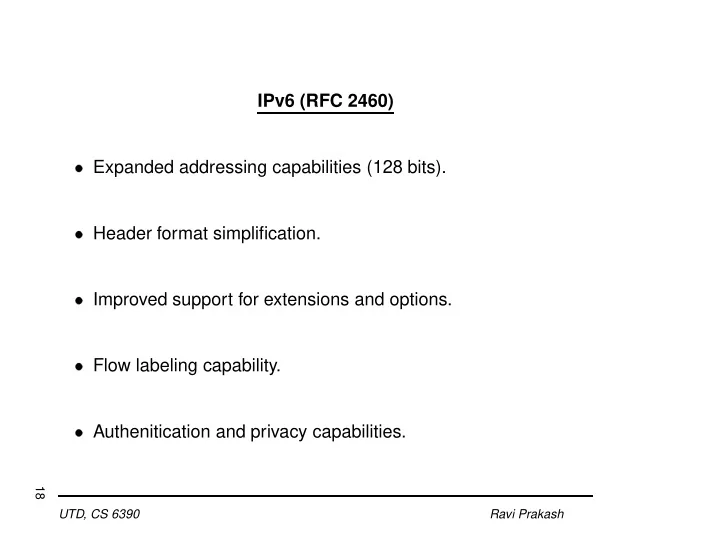

IPv6 (RFC 2460) � Expanded addressing capabilities (128 bits). � Header format simplification. � Improved support for extensions and options. � Flow labeling capability. � Authenitication and privacy capabilities. 18 UTD, CS 6390 Ravi Prakash
IPv6 Packet Format Traffic class: to assign priorities to packets (for differentiated services ). Flow label: to label sequences of packets indicating special handling. Payload length: in octets (included extension headers). Next header: type of extension header (if any). Hop limit: replaces TTL. 19 UTD, CS 6390 Ravi Prakash
IPv6 Extension Headers � Recommended order of extension headers. � Extension headers processed only in the order they appear in the packet. � Hop-by-Hop option header immediately after IPv6 header. � Only Hop-by-Hop options header processed by every node on path from source to destination. � Other extension headers processed only by destination. � Packet discarded and ICMP message sent to source if expected header not found. 20 UTD, CS 6390 Ravi Prakash
IPv6 Extension Headers (contd.) Routing Header: similar to IPv4’s loose source and record route option. � Swap IPv6 destination address with next address in list. Fragment Header: used by source to indicate fragmentation. � Intermediate routers not allowed to fragment packets. � Destination expects to receive all fragments within 60 seconds of the first arriving fragment. 21 UTD, CS 6390 Ravi Prakash
IPv6 Packet Size Issues � MTU should be at least 1280 bytes. � For links with smaller MTU, lower layer fragmentation and reassembly required. � Path MTU discovery is recommended. 22 UTD, CS 6390 Ravi Prakash
IPv6 Stateless Address Autoconfiguration (RFC 2462) � Avoid manual configuration of nodes. � Node generates its own addresses using: – interface identifier created using locally available information, – subnet prefix advertised by router. � Interface IP address = subnet prefix + subnet unique interface id. � Duplicate Address Detection performed to ensure uniqueness. 23 UTD, CS 6390 Ravi Prakash
Lifetime of Interface Addresses � Interface’s IP address has finite lifetime. � On lifetime expiry: – address binding becomes invalid. – address may be reassigned to another interface. � Preferred address: address can be used for communication without restriction. � Deprecated address: invalidation of this address binding is imminent. 24 UTD, CS 6390 Ravi Prakash
Stateless Autoconfiguration Protocol 1. Node generates link-local address for interface. 2. Node verifies the uniqueness of tentative link-local address. 3. Node obtains router advertisement and composes address. 4. Node refreshes address binding on subsequent advertisements. 25 UTD, CS 6390 Ravi Prakash
Generation of Link-Local Address � Use link-local prefix FE80::0 . � N-bit long interface id replaces right-most N bits of link-local prefix. � Interface id may be interface’s link-layer address. � Another alternative is 64-bit address based on EUI-64 identifiers. 26 UTD, CS 6390 Ravi Prakash
Verification of Uniqueness � Node sends Neighbor Solicitation message containing tentative address as target. � Uniqueness guaranteed if no Neighbor Advertisement with tentative address received in response. � Otherwise, manual configuration has to be done. 27 UTD, CS 6390 Ravi Prakash
Processing Router Advertisements � Node listens for router advertisement. � Send Router Solicitations to all-routers multicast group to obtain advertisements quickly. � Advertisements contain subnet prefix and lifetime . � Generate address using prefix and interface id, provided advertised lifetime is positive. � Subsequent advertisements can refresh binding or add to information received earlier. 28 UTD, CS 6390 Ravi Prakash
Recommend
More recommend